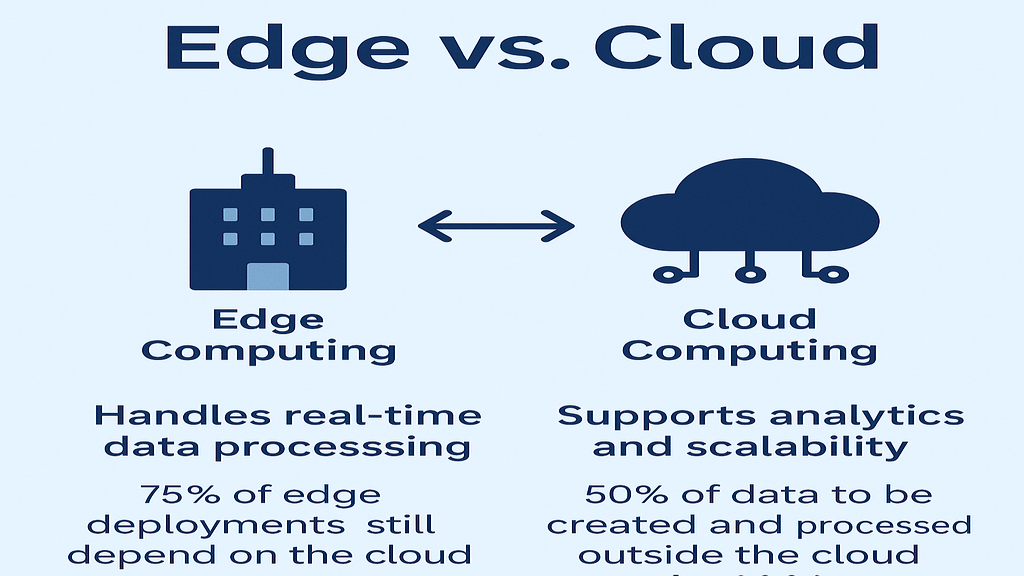Mobile edge computing is that transformational technology that emerged to counter the latencies, bandwidths, and real-time processing associated with modern applications, from an autonomous vehicle to a smart city as MEC is the method of processing data closer to the source to achieve unimaginable speed and efficiency. At the center of the ecosystem are edge nodes-these are fundamental building blocks that empower edge computing.
Here, the role of an edge node becomes much more important. It puts computing power closer to where it is needed and brings significant reductions in stress to centralized data centers. In this article, we will take a look at the architecture that comprises an edge node, delve into its elements, and analyze its transformational potential.
Covered Contents
ToggleWhat are edge nodes?
Edge nodes are local computing units that have strategic positions within a network, designed to facilitate low-latency data processing and communication. In contrast to central data centers, edge nodes operate closer to end-users or devices and thus enable faster responses without relying on core network infrastructure. This proximity enables applications that require real-time analysis of data, such as autonomous vehicles or remote surgeries, to function smoothly.
Types of Edge Nodes:
Micro Edge Nodes: These are deployed at the device level and can handle immediate, small-scale processing tasks. These are often embedded in IoT devices such as smart sensors or home automation systems.
Regional Edge Nodes: It sits at intermediate locations like base stations or small data centers and supports aggregate processing for multiple devices. Regional edge nodes act as a middle layer between micro edge nodes and the cloud.
Device-Level Edge Nodes: Integrated directly into devices such as smartphones, industrial robots, or autonomous drones, offering ultra-localized computation.
Core Components of Edge Nodes End
Edge nodes consist of several critical components, ensuring efficient functionality and scalability. These include:
Processing Units
Purpose: It performs local computation and minimizes the need to transfer data to remote servers.
There are different types: CPUs for general-purposes, GPUs for high-performance computing, and TPUs for AI applications. Field-Programmable Gate Arrays (FPGAs) are now also getting popularity in use for specific, reconfigurable computing tasks.
Examples: These include image recognition inference in AI, natural language processing at the edge, and real-time decision-making in autonomous vehicles.
Importance: Importantly, processing units form the core of an edge node. The nodes offer the real-time analytics and decision-making functionalities required by those applications such as predictive maintenance in manufacturing or face recognition in security systems.
Storage Solutions
Onboard storage – available to use to cache, preprocess, or temporarily store latency-sensitive application data.
Technology: SSDs, which are faster and more reliable than traditional hard drives. The newest emerging technologies include NVMe (Non-Volatile Memory Express) drives.
Use Cases: Sensor data in smart factories can be cached locally for quick analysis and transmitted to the cloud. Similarly, video data in surveillance systems can be stored and processed locally for real-time detection of anomalies.
Scalability: Most modern edge nodes utilize scalable storage solutions in support of varying data volumes.
Networking Modules
Connectivity: it comes with 5G, Wi-Fi 6, and Ethernet high-speed interfaces, and it allows for fast communication among the devices and the core network.
Features: Support the integration of SDN and NFV into the platform to optimize dynamic traffic flow and resource utilization.
Role: The networking modules constitute the backbones of edge nodes so that such devices may send processed data or get updates from the central system. For instance, for connected vehicles, the modules in the networking enable in-time communication with the management systems of traffic.
Future Trends: In addition, Low Earth Orbit satellite networks hold huge excitement as emerging alternative edge network approaches towards some underserved or remote geographies.
Power management
Energy Efficiency: It is an important aspect to reduce cost and supports sustainable practices and helps edge nodes operate adequately in power-constrained deployments.
Backup Solutions: The system shall use UPS systems, to say the least; with solar panel integrations included for higher reliability at isolated or off-grid areas.
Challenges: Power management becomes particularly significant for edge nodes deployed in harsh conditions or mobile, such as drones or cars.
Technological innovations: The advanced power management chips and adaptive power modes are in development to further improve energy efficiency.
Security Features
Protocols: The Trusted Platform Modules, Secure Boot, and end-to-end encryption in embedded security mechanisms ensure protection against cyber threats in the edge nodes.
Challenges addressed: Difficulties Copied With With the distribution nature of Edge nodes, risks such as data break-in, gadget tampering, and illegal access mainly present themselves.
AI for Security: More machine learning algorithms are being used by anomaly-based intrusion detection and counteraction techniques for real-time detection of anomalous behavior.
Case Studies: Healthcare systems rely on edge nodes to process sensitive patient data, requiring strong security to be compliant with the regulations such as HIPAA.
Deployment Models of Edge Nodes
On-Premises Edge Nodes: Located within facilities to meet specific enterprise needs, such as in manufacturing or healthcare. These nodes offer greater control over data and operations.
Cloud-Managed Edge Nodes: It is monitored and maintained by the cloud providers, so it is easy to scale. The costs associated with up-front costs are also less. For example, edge computing is extensively used by CDNs and gaming platforms for delivering better user experience.
Hybrid Models: This combines on-premises and cloud-managed nodes, balancing performance, cost, and scalability.
Challenges in Designing and Deploying Edge Nodes
Despite the advantages, edge nodes face several design and deployment challenges:
Scalability: the possibility of adding an edge node to grow its workload size without requiring much redesign as the IoT ecosystem continuously continues to add more devices.
Environment: This brings along aspects such as temperature, space, and dust. Edges nodes are being designed to be ruggedized so as to be used in adverse industrial or outdoor environments.
Integration: The biggest challenge is the compatibility of the legacy system and existing network infrastructure. Mostly, organizations have to spend on middleware solutions to bridge the gap.
Cost: Performance versus affordability. This could be a significant challenge to the small and medium-sized enterprises.
Future Trends in Edge Node Architecture
Edge node technology advances through AI, cloud computing, and green technology. The following are the trends that have made their mark:
AI-Driven Resource Allocation: Smart algorithms to optimize computational and network resources. This distributes workloads dynamically across available nodes, maximizing efficiency.
Containerized workloads: Applying container technologies, like Kubernetes, to ensure seamless and efficient application deployment. Containers also ensure seamless scaling and the portability of applications among multiple edge nodes.
Sustainable Design: Concentration of energy-efficient hardware, sources of renewable energy, and methods of reduction of e-waste. Green computing is an activity becoming very necessary for most organizations.
5G Integration: The rollout of 5G is on a huge scale; therefore, edge capabilities will expand, and it allows the possibility of applications which includes AR/VR fully immersed experience and infrastructure.
Conclusion:
The heart of mobile edge computing lies in the edge nodes that bring the power of processing closer to the end-users and devices. Understanding their core components and addressing the deployment challenges will help organizations realize the full potential of MEC. Advances in the architecture of edge nodes will revolutionize industries by bringing faster, smarter, and greener computing solutions to the world. The future of edge nodes really lies in their adaptability to ever-evolving technologies as well as user demands; these nodes are expected to be on the edge that will eventually create a connected world, an efficient world, and a sustainable world-supporting everything from transport to healthcare in remote places.




4 thoughts on “Edge Nodes: The Structural Backbone of Mobile Edge Computing”